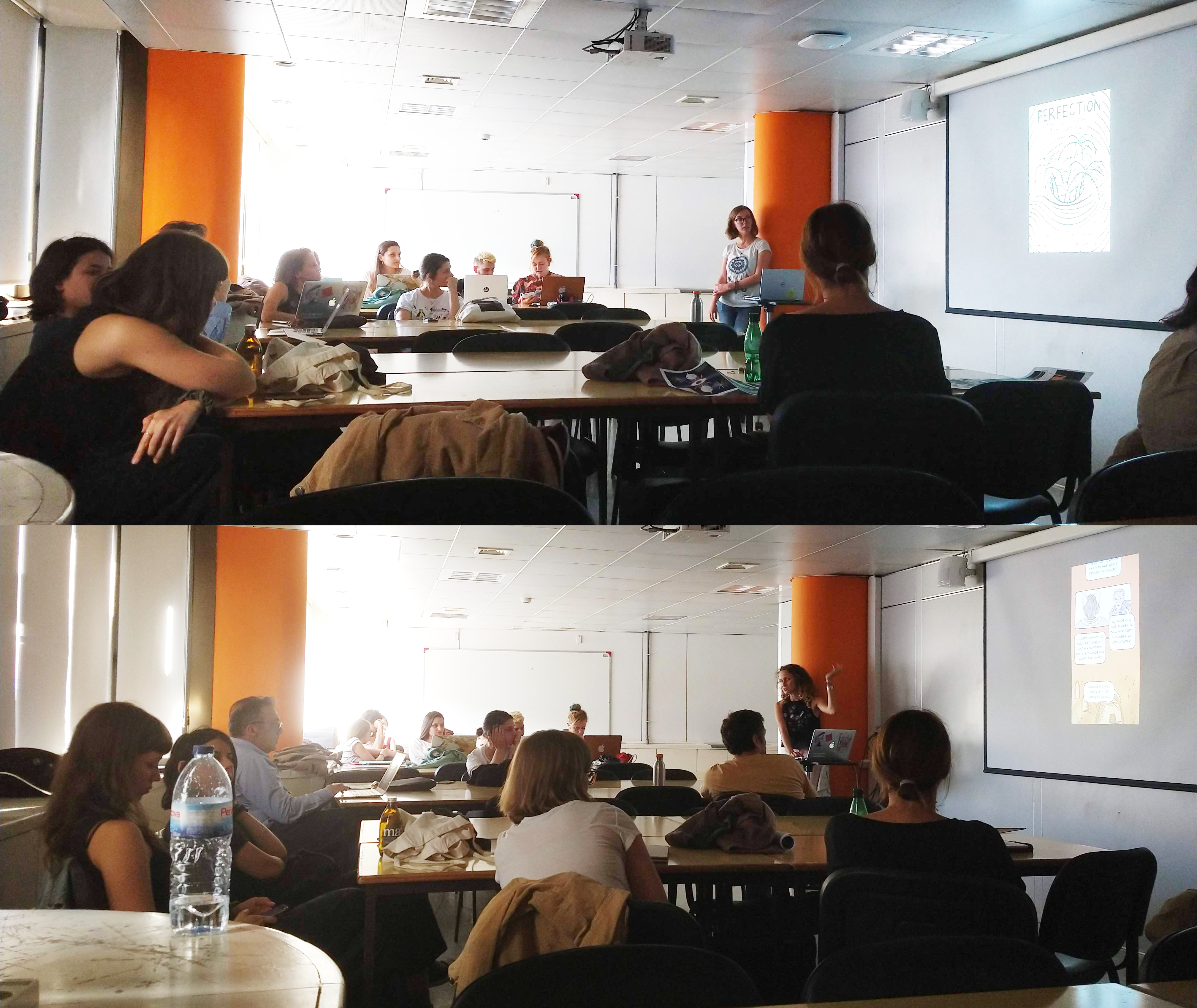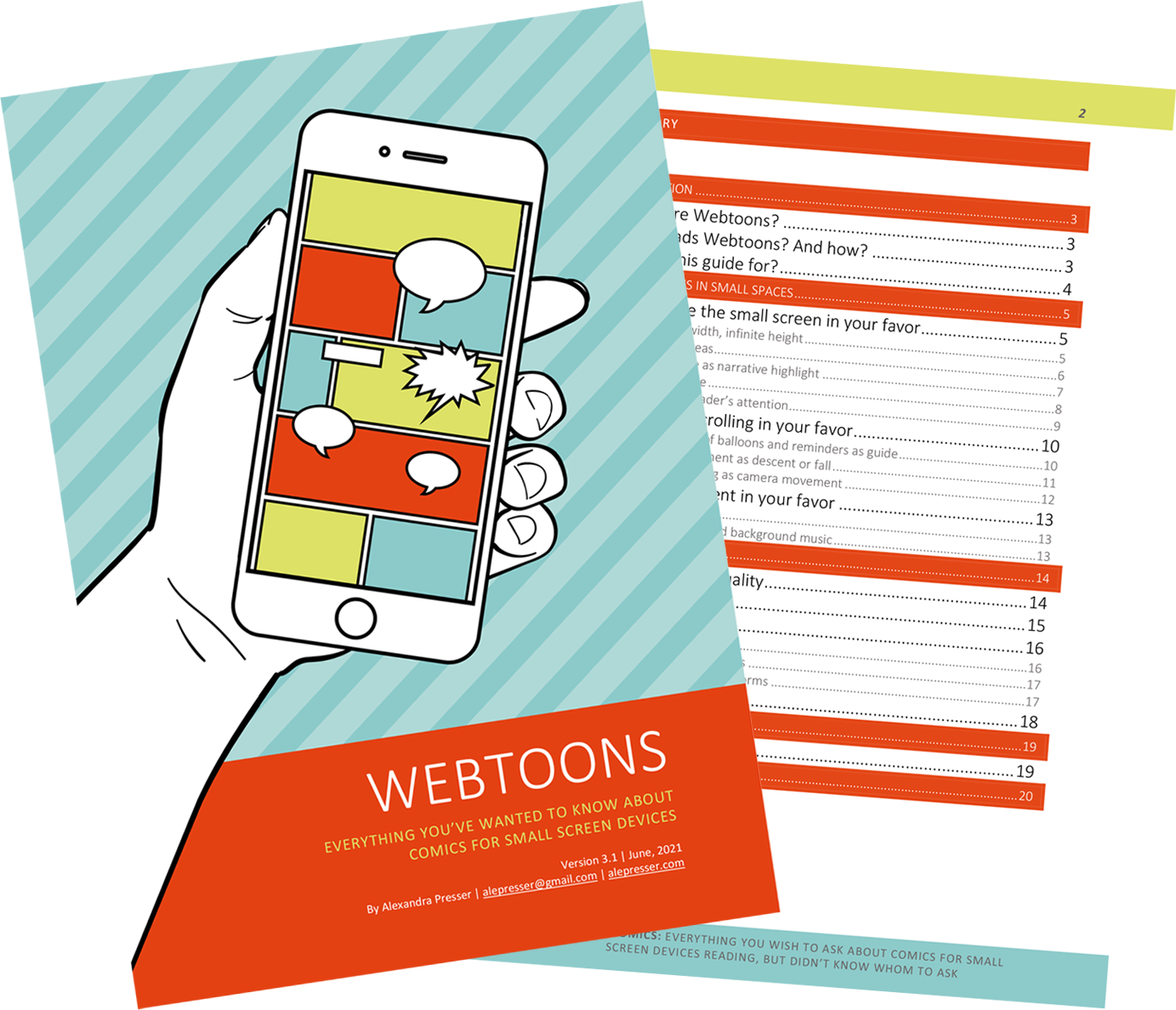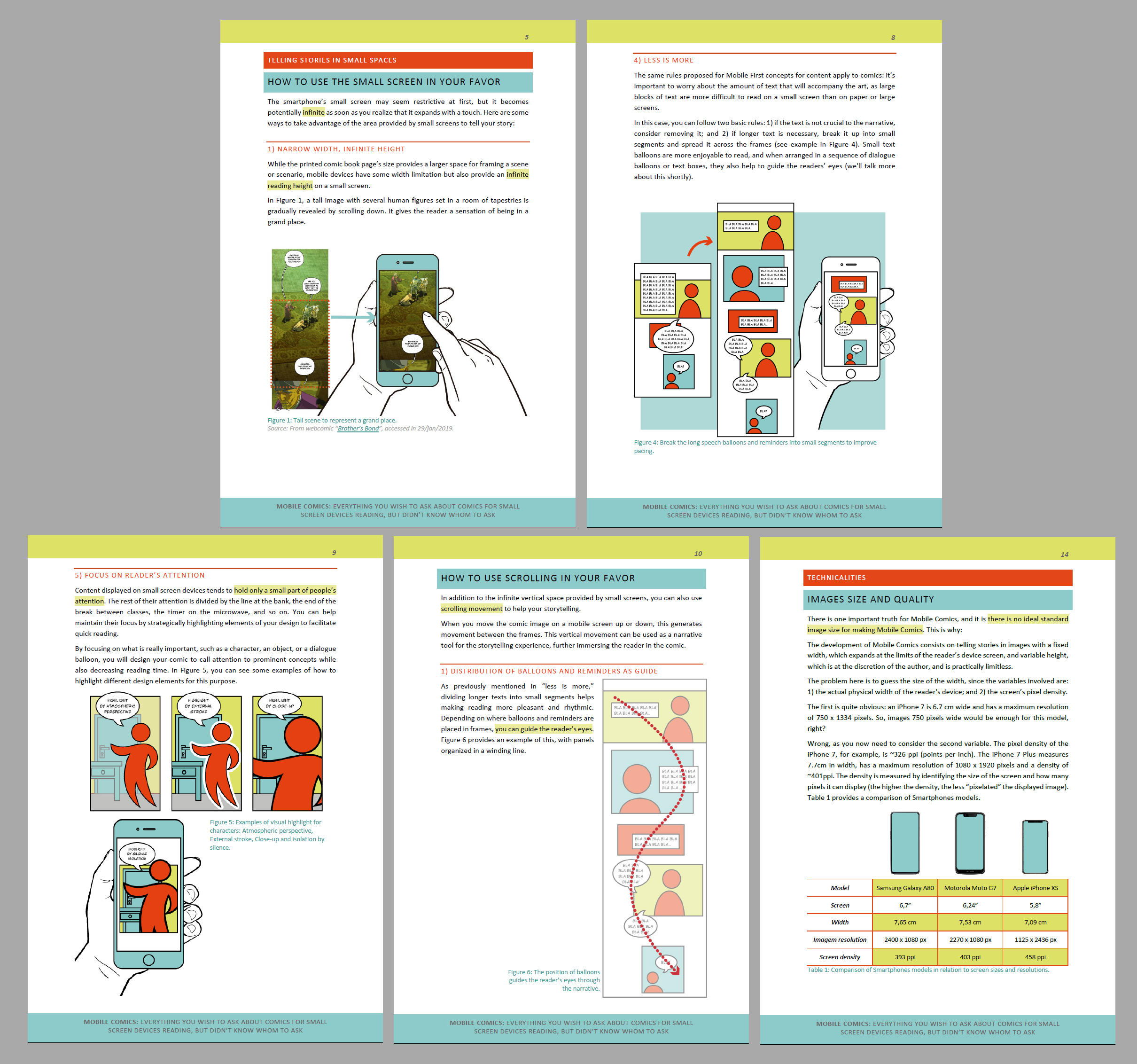1. Introduction
When talking about comics, the immediate mental response goes to printed magazines, whether in a monthly smaller format, with lower prices and longer runs, or in Graphic Novels, with more expensive finishes and limited distribution. However, this media has evolved, migrating from paper to digital environments, not necessarily taking its already consolidated public with them, but instead reaching a new one.
This webcomics audience rise that keeps classic1 comics public unaffected can be exemplified, on the one hand with “Lore Olympus’” success (Fig. 1), created by Rachel Smythe and published on Webtoons.com platform, which has more than 15 million daily readers. This guaranteed, in 2019, the contract with a production company to turn the webcomic into an animation series (Boucher, 2019). Then, on the other hand, with the increase in comic book sales in the US and Canada in 2018:
According to a new study by ICv2 and Comichron, total comic book sales to consumers in the United States and Canada were around $ 1.095 billion in 2018, $ 80 million more than in 2017 and $ 10 million more than the previous record of 2016 (Nascimento, 2019).2
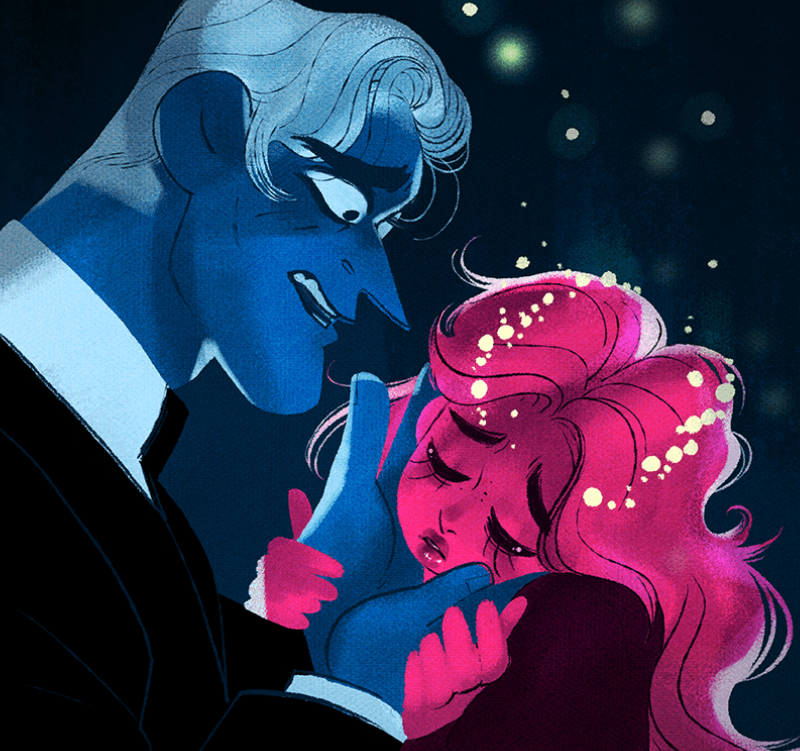
Source: Webtoons platform, available at https://www.webtoons.com/en/romance/lore-olympus/list?title_no=1320
Fig. 1 Lore Olympus, by Rachel Smythe
In other words, webcomics audience readers grow without diminishing classic comics. There is a natural tendency to migrate from printed comics to digital environments to reach this audience, but while this adaptation has favorable results on larger screens, such as tablets and computers, it is not so satisfactory on smaller screens as digital readers and smartphones. As a result, in 2010, several academic studies are searching for methods to read large pages on small screens, mainly through the fragmentation of panels, but showing unsatisfactory results (Presser, Braviano & Côrte-Real, 2019; Presser, 2020).
By avoiding the idea of panel fragmentation for readability on a small screen, a path for a more specific point of view surfaces: what characterizes comics developed for small screen devices reading? And how to help the artists in this development?
The purpose of this article is to propose a parameter guide to assist in the development of webcomics created specifically for reading on small screen devices.
2. Webtoons
The popularization of small screen mobile devices, such as digital readers and, mainly, smartphones, is a worldwide reality. As a result, there is a growing concern in countries with an extensive production of comic books to transpose these printed publications to such devices.
Currently, any media that offers information or entertainment already presents small screen devices’ reading-friendly versions. The concern with receptivity ranges from reorganizing websites to make reading enjoyable for those who consume the content on their smartphones to, for example, descriptive subtitles for silently watching videos in public places. Thus, considering the market’s interest, it is reasonable to expect researchers seeking to bring comics content into digital by focusing on small screen devices.
However, as Schade states, “Mobile designs need to do more than shrink a desktop experience to a smaller screen” (Schade, 2017). In the webcomics’ case, a mere reduction in the size of pages originally created to be read on big sheets of paper (or bigger screens) may not achieve the visual impact intended by the comic artist (Fig. 2).
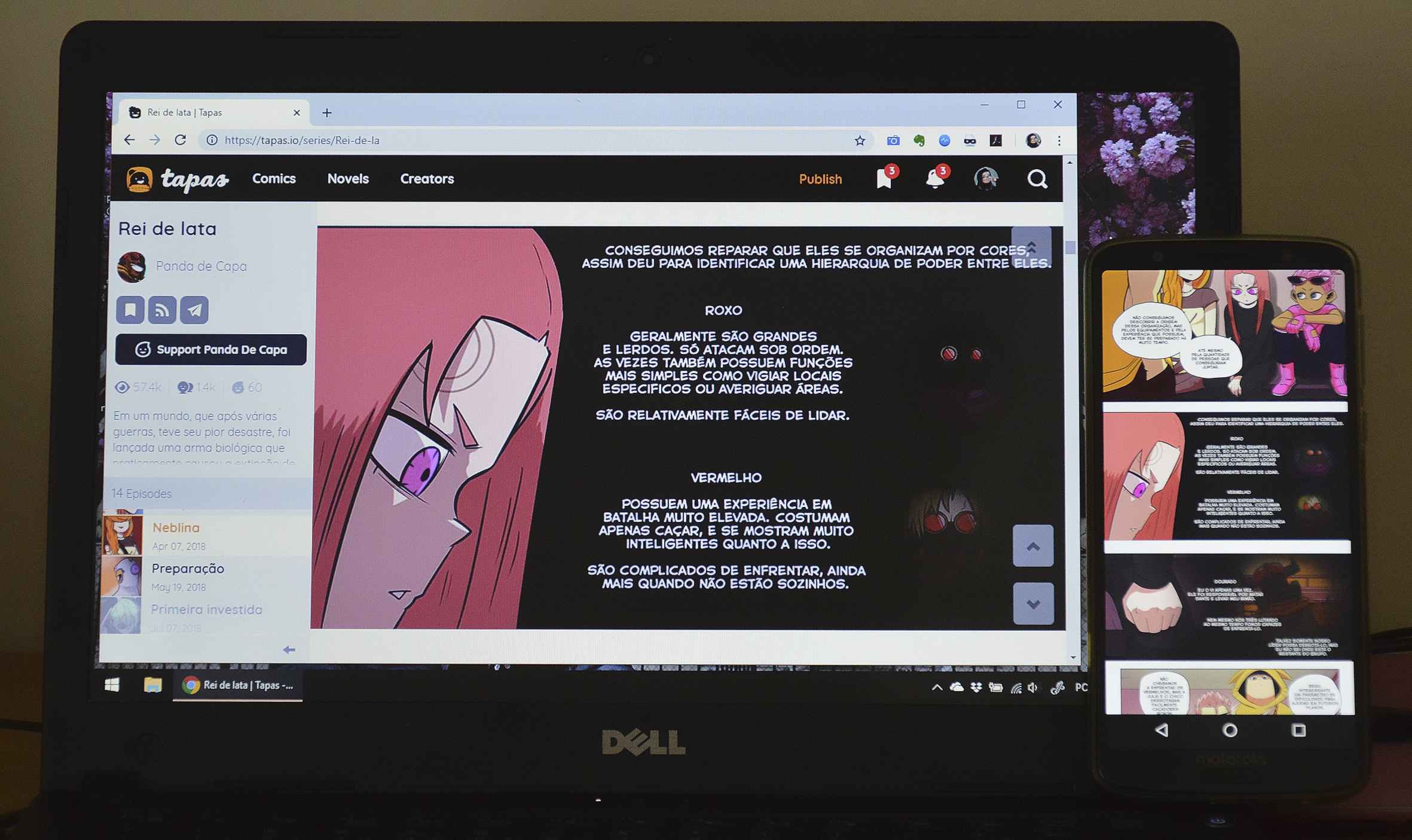
Source: Rei de Lata on Tapas, available at https://tapas.io/series/Rei-de-la/info
Fig. 2 The Webcomic “Rei de Lata”, on Tapas, as seen on a computer screen and on a smartphone, with compromised readability
According to the study already published regarding the observed characteristics of Webtoons in content platforms, which, as well as this article, is part of a larger study (Presser, Braviano & Côrte-Real. 2019), these following ten design characteristics stand out: simplicity, breathing areas, bigger lettering, identification, dramatic unities in panels or clusters, use of screen width, silence areas, vertical reading, hypermedia, and narratives of varying sizes.
With these elements identified, this study set up a field research plan to develop and infer the content of a parameter guide for Webtoons development, as described in the next section.
3. Field research and methods
In order to develop said parameter guide for Webtoons, the following plan was outlined and executed, as thoroughly described in Presser (2020):
Phase 1:
Phase 2:
Application of the guide’s first version to comics’ students.
Updating the guide using classroom observations and notes.
Phase 3:
Request verification of the guide to comic book professionals.
Finalization of the guide based on the observations of these professionals.
This plan was carried out between 2018 and 2019, published and defended in the author's doctoral dissertation in March 2020 (Presser, 2020), as detailed in the next session.
1.1 Phase 1: Webcomic artists and the guide’s first version
As previously presented, Phase 1 included data collection through interviews with webcomic authors, aiming at practical creation knowledge. We tried to understand the main characteristics considered when developing their creations to obtain good results on small screen devices reading.
At this stage, 15 authors were interviewed, 8 of them from Brazil, 5 from the United States and 2 from Germany. Their age average is 29 years old, the youngest being 21 years old and the oldest at 35 (as of 2018-2019). There are 9 female cisgenders and 6 male cisgenders (despite attempts, it was not possible to contact authors of other genders, who are quite popular in this sphere of digital creation), and they publish on platforms such as Hiveworks, Tapas, Webtoon, and social networks such as Tumblr, Facebook, Twitter, and Instagram, in addition to personal websites.
The main topics gathered from the interviews revolved around the following:
Webcomic artists tend to start their publications with little to no prior knowledge of the subject, learning in practice how to qualify their work.
To optimize reading on mobile devices, they seek to make large frames and control pacing by scrolling.
As a recurring concern to optimize small screen reading, they cited: frame width; font size; balloons organization, as well as the amount of text in them; and highlighting the characters on the panels for better visual reading.
Some pointed out a concern with lettering. At least 8 of the 15 respondents confessed they have little to no concern about this issue. Some stated that, they publish the webcomic first and then, if they notice that reading was compromised, they fix and redo the publication.
Echoing previous results, there is a controversy with the use of hypermedia in digital comics. The justifications range from fear of compromising what is meant by "comics", adding elements that would make them too hybrid, to the lack of technical knowledge of the authors to perform the task. Globally, moderate use of animations and sound effects with narrative meaning, such as stories that talk about music, are supported.
All interviewees who monetize their publications said that there is no unique way to make money from webcomics. The solution is always to fund the work in different ways, adding small amounts from different sources, to obtain what makes all the work possible. The most suggested monetization strategies were crowdfunding, website advertisements, merchandising, textbooks licensing, print publication, and indirect events and activities - such as workshops and courses.
1.2 Parameter guide first version
Based on previous observations of Webtoons content platforms (Presser, Braviano & Côrte-Real, 2019), and in the results of the first phase of the research, the first version of the parameter guide for Webtoons was presented in a 19 pages PDF, illustrated, and A5 sized. The proposal aims for a small-size file, easily distributed over the internet, and with simple reading.
The subjects covered by the parameter guide on the design of small screen reading webcomics were organized as follows:
An introduction to Webtoons and its target audience.
The main visual characteristics of Webtoons, in topics:
Narrowed width and infinite screen, with explanations of limitations and advantages of creating for small screen reading.
Silence Areas, introducing this nomenclature for Webtoons, which are broader gutters used to highlight scenes and provide design breathing room.
Panels size as a narrative highlight, emphasizing the importance of scaling scenes for drama.
“Less is more”: insertion of “Mobile First” principles in the context of webcomics.
Focus on the dispersed reader’s attention.
The distribution of balloons and reminders as a guide, showing the importance of fluid organization of texts in the webcomics layout to assist reading.
The screen movement as downward or fall camera: using screen scrolling as a design element in the construction of the narrative is demonstrated through images of webcomics published online.
Animations and sound effects, presenting the concept of inserting hypermedia in webcomics.
The main technical characteristics necessary for Webtoons development:
Image’s size and quality.
Texts.
Digital publishing (personal website, Social Network Sites, and Content Platforms).
Monetizing.
The target audience of this material are beginner comic artists, who seek to understand the visual language for Webtoons development and its publication on content platforms. Thereby, aiming for better acceptance and diffusion among these individuals, the guide was written using colloquial language, but without excluding academic references. The technical illustrations are works of the authors of this study. The examples of applications of certain parameters have as sources webcomics published online, providing links for readers to access the original works.
This first version of the Guide, which was written in Portuguese (Brazilian) and translated into English, was not made public, having served as support material for the sample of the second phase of the research, as explained below.
1.3 Phase 2: Comics Students
In phase 2, the comics students who would create a Webtoon as a class assignment used the parameters guide as support material. The first author of this study accompanied the class, aiming to:
assist students with practical and theoretical problems, which may provide additional content to the guide in the future.
evaluate the application of the guide as didactic support material for beginner comic artists; and
collect, in loco, with students, opinions on the information provided in this material.
The second phase of the research took place during the author's period as a guest researcher at IADE - Universidade Europeia, Lisbon, Portugal. Prof. PhD Eduardo Côrte-Real, who acted as the author's co-supervisor, taught the course used as the sample for this research: Illustration and Comics (Ilustração e Banda Desenhada). The discipline is part of IADE's Master's Program in Visual Culture. The Sandwich Doctoral Program period in question was made possible by CAPES-Brasil, through Call for Applications nº47 / 2017, selection 2018, with support from UFSC in Brazil and IADE and UNIDCOM in Portugal.
A total of 24 students participated in the study (12 from an afternoon class and another 12 from an evening class) from the following countries: Brazil, Portugal, Italy, Colombia, Austria, and Spain, all between 21 and 38 years old.
These students should complete an assignment to obtain their final grades. This assignment, developed in conjunction with Prof. Eduardo Côrte-Real, consisted of creating a webcomic, focused or not on small screen devices.
To test the efficacy of the parameter guide, the establishment of two groups was necessary. One group, the evening class, received the parameters guide as support material. The other group, the afternoon class, served as the control group and did not receive the guide. All students were aware of the research, and the afternoon class received the parameters guide after the assignment delivery at the end of the semester (Fig. 3). Thus, with the students' permission, this study had the opportunity to compare webcomics developed by beginner cartoonists who had access to the support material against those who did not have access to the first version of the parameters guide.
The following observations were made by the author:
Despite being comic readers, the concept of reading this media on mobile devices was new to students. This lack of familiarity with the subject was evident in presented works, with compromised small screen readability in most cases, and with greater incidence in the control group.
On the other hand, in the evening class, which had access to the parameters guide, there was a higher quality of narrative and design in presented works. Variations in panels size for dramatic emphasis, adequate use of lettering and design were some examples of aspects identified.
Among the main elements to be highlighted are: the use of larger lettering, enabling legibility on small screens; areas of silence; simplicity; and using screen width more effectively.
The evening class students stated, in conversations during classes, that the parameter guide was fundamental to the initial notion of how to work with the media specifications. They also mentioned that it facilitated the visual planning from printed page design to screen and that some of the topics covered seem obvious in theory, but not in practice.
Overall, students expressed positive opinions about the support material offered by the parameter guide. Even with all the positive feedback, some comments from the students elucidated flaws that need rectifying in the first version. Among them:
Deepen and further detail the technical specifications on image and text sizes.
The concept of variable height in mobile devices was vague - most students asked for more explanations about the topic during class.
Students used very few hypermedia resources, and the ones who tried to use them expressed concerns about “how much is enough” or “how much is too much”.
Most students had technical questions about the files to be published on the content platforms.
With the information gathered, this study moved forward to the second version of the guide. Comic books professionals and academics were responsible for the evaluation of the second version of the parameters guide.
1.4 Parameter guide second version
The second version of the parameters guide, which was also later translated into English, had some content updates, based on the students' observations and the author’s assessment. Among the changes, the main ones were as follows:
Image captions, including links to webcomics, have been reduced from long URLs to clickable links allowed by PDF technology. Since there are no intentions of distribution in print of the guide, long links were unnecessary.
The topics "Screen movement as a camera" and "Screen movement as descending or falling" have been reversed.
The entire topic on hypermedia went through adjustments, to clarify its possible inclusion in Webtoons.
The item on technicalities, which elucidates screen resolutions and image sizes, has been rewritten and expanded, with tables and image insertion.
The text was revised, as well as the layout and colors.
Overall, there were few changes, all focused on a material with a more cohesive and consistent appearance.
1.5 Phase 3: Comics Professionals
Finally, in phase 3, comic professionals and researchers evaluated the guide’s second version, making a critical assessment. The sample included 13 participants: ten from Brazil and three from the United States. They work in various roles related to comics, acting as artists, screenwriters, editors, translators, and academic professors; some with few years of experience, others with long careers in publications. The average age was 37 years old, with the youngest professional being 26 years old and the oldest being 63.
The replies sent by the professionals ranged from short answers to in-depth analyses on each topic offered in the guide. After reading and organizing the information from these responses, these are the main points:
Regarding the size of the guide, some participants mentioned that it would be interesting to reduce the overall size, cutting texts, omitting some details and perhaps, making more use of images and infographics. The justification is that comic artists tend to be more visual people and might find the guide monotonous. Other participants commented that, because the subject is so interesting, it deserved further study, examining the issues raised and expanding the proposed discussions.
There was also disagreement regarding the use of academic references, mainly on image captions, which indicate where they were taken from, providing links and sources. Some of the interviewees suggested removing all these references and perhaps making an index at the end of the Guide, citing the origin of the images. Others commented that the references were incomplete.
English-speaking participants commented that, grammatically, the guide’s English version was correct. Although, there were mentions of expressions that did not make much practical sense. A review by a native English speaker would solve this issue.
Especially among practical comic book professionals, the comment “I wish I had access to this type of material when I was starting” was referred to more than once. Echoing what a student from the research’s second phase commented, they stated that the information is quite basic and, precisely for this reason, necessary for a broader understanding of the development of webcomics for small screens.
Globally, the participants in this phase expressed their agreement with the assessment of what is proposed by this study and with the development of this guide: to assist and expand the knowledge of comic artists, beginners in Webtoons, in a professional manner. Among all the comments, two attracted attention. The first is from a participant who works with comic book editing that states, “your guide woke me up for dozens of other theoretical questions that are linked to my daily life”. The second is from an academic, who commented, “I think it is an extremely valid contribution for comic authors, particularly (but not only) of this genre, Webtoons, and which appears at an exceptional time, considering that this market is still evolving”.
One interviewee stated that the guide works as a support material for beginners. However, it assumes that such a beginner already has some prior knowledge about classic comics and is adapting to this new genre. They state that it would be interesting to propose other readings and sources of information for these beginners who do not have basic knowledge about this medium, such as element nomenclature and visual narrative techniques. They mentioned Scott McCloud’s books (McCloud, 2005; 2006; 2008) as a good solution for both.
The parameter guide reception was positive among all participants, who praised its beneficial use by beginners in this new genre. However, it is necessary to carefully analyze the suggestions made, both for contradictions and for essential choices regarding the intentions of this material.
The decisions made from these suggestions, therefore, are listed below:
The parameters guide will maintain its amount of content, with the addition of a few references, which will be further explained in the following items of this list. This study agrees that the subject could be more detailed. However, the idea of being a quick and friendly reading guide for beginning professionals prevails. If there is a greater interest in delving into each topic, the professional may be invited to read the entire study in the doctoral thesis where it was originally defended or in its resulting articles, such as this one.
The colloquial language of the text will be maintained, but some more academic references will be inserted in the text. It was clear that pointing out in the guide where some terms and concepts came from is fundamental, given that readers are not necessarily expected to access the full research, where the authors are cited and referenced.
An initial text will be added indicating clearly to whom the Guide is directed - cartoonists beginning in Webtoons. In order to reach wider audiences, a list of bibliographic references will also be added at the end of the guide, both to credit the books from which some of the topics covered originate and to help readers with little experience in the area.
A general review of the Guide should be carried out, seeking to make clear the proposed target audience - novice professionals - and indicating the reading of other more in-depth books on the subject.
In total, this research counted with the collaboration of 52 individuals, being 15 authors of webcomics, in phase 1; 24 masters students, in phase 2; and 13 professionals from different areas of expertise related to comics, in phase 3, who provided various suggestions, intending to gauge and improve the final material.
1.6 Parameters guide final version
Based on an extensive theoretical foundation, analysis of content platforms, and the qualitative field research mentioned above, this study presents, in this section, the final version of the proposed parameter guide for Webtoons development (Fig. 4 and 5).
The final version of the parameters guide followed the advice from professional participants. Thus, there was the addition of some content although, the layout remained unchanged. On that account, the PDF file went from 19 to 20 pages, remaining with less than 2MB, which will hopefully contribute to its online distribution. The final downloadable version was made available on the author's personal website, free of charge.
Acknowledgements
The present study started from a gap perceived by the authors in their academic studies regarding comics and hypermedia. On the one hand, there are several publications on both printed and webcomics. On the other, on media and technology aimed at the usability of content for small screen devices, motivated mainly by the great worldwide interest in this type of device. Therefore, the focus of this study is on the intersection of these two subjects.
For this reason, the research question asked was: How to help the development of webcomics focused specifically on small screen devices reading? As an answer to this question, this study proposes a parameter guide, tested by beginners in the area and evaluated by professionals, to assist on webcomics development created for small screen reading.
Thus, followed the creation of a research plan, containing interviews with comic artists who already have experience with this media, application of the guide to master’s students of a discipline focused on the development of comic books, and the critical evaluation from professionals of different areas related to comics. The result of the information obtained and the theoretical foundation, added to the data collected from the three phases field research, enabled the parameter guide development for Webtoons creation.
Furthermore, the data collection presents some cultural breadth: among its participants in the three phases, Brazilians, Portuguese, Italians, Bolivians, North Americans, Germans, and more were present. The cultural breadth was possible because of the time spent at Lisbon, Portugal, through the Sandwich Doctoral Program, with the support of IADE - Universidade Europeia, and CAPES-Brasil scholarship PDSE.
The guide, therefore, consists of a 20-page PDF with concise indications for novice cartoonists in this genre. It includes aspects of Design that differentiate Webtoons from classic comics. It also encompasses technical information regarding file formats and sizes, financial viability for the artist and reading instructions to deepen the knowledge of visual narratives.
This guide aims to make the experiences of novice cartoonist professionals less dispersed and more efficient. Thus, assisting them with the accomplishment of their projects for this specific subgenre. In addition, the theoretical and practical backgrounds presented will hopefully contribute to the visibility and academic understanding of Webtoons, bringing to this genre the same respect and diversity of publications of classic and web based comics.
Therefore, we suggest future studies that may arise in this area of interest, as these topics appeared in this study, but not thoroughly analyzed. Among them are:
Lettering, based on the idea of images to be read on a small screen, considering the variations in size and the screen resolution of mobile devices.
An approach from the point of view of this genre’s publishers, since this study focuses on independent production.
To carry out a survey with the readers of this comics genre. This audience despite recent, is faithful and engaged, whether through platforms or RSS readers.
Furthermore, due to the fast obsolescence of products linked to the digital universe, it is important to mention that the final version of the parameter guide for Webtoons presented in this study, as well as all the published content about a phenomenon that takes shape on the internet, tends to become out of date very quickly. Academically, it is extremely important that this type of topic is constantly studied and updated, as the creation of online content changes and reinvents itself every day and with increasing speed. For this reason, the parameters guide here presented is available to download at the author’s personal site already in its 3rd version, by the time this article has been published.














